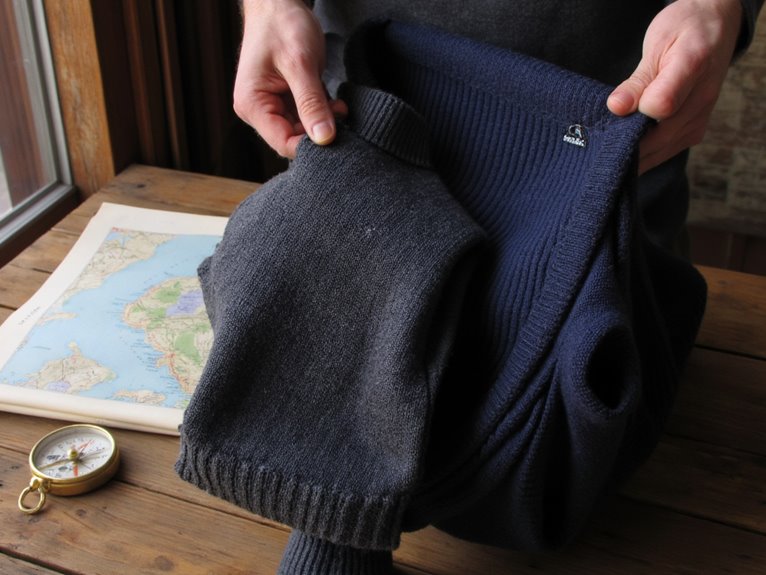How to Choose and Fit Thermal Underwear for Cold Weather Backpacking
You’ll need synthetic fabrics like polyester or merino wool for effective moisture wicking, avoiding cotton which traps dampness and causes heat loss. Choose lightweight (150-200g) for temperatures above 32°F, midweight (200-300g) for 0°F to 30°F, or heavyweight (300g+) below 15°F. Guarantee a snug fit with finger clearance under cuffs, complete wrist and ankle coverage, and flatlock seams to prevent chafing. Proper selection depends on understanding how these technical specifications work together for peak thermal performance.
We are supported by our audience. When you purchase through links on our site, we may earn an affiliate commission, at no extra cost for you. Learn more. Last update on 16th December 2025 / Images from Amazon Product Advertising API.
Notable Insights
- Choose synthetic fabrics or merino wool for thermal underwear; avoid cotton as it traps moisture and causes dangerous heat loss.
- Select weight based on temperature: lightweight for above 32°F, midweight for 0-30°F, heavyweight for below 15°F conditions.
- Ensure snug fit with finger clearance under cuffs while covering wrists and ankles completely to prevent cold spots.
- Prioritize moisture-wicking properties and odor control features, especially merino wool’s natural resistance or synthetic antimicrobial treatments.
- Consider ordering one size up and choose flatlock seams for comfort during extended wear and movement.
Understanding Fabric Types and Their Cold Weather Performance
When you’re selecting thermal underwear for backpacking, the fabric choice determines whether you’ll stay warm and dry or face dangerous heat loss in cold conditions.
Synthetic fabrics combine polyester, nylon, spandex, and lycra to optimize moisture wicking and heat retention. Polartec leads industry standards for synthetic base layers. These materials excel at staying dry by efficiently wicking sweat and maintaining comfort during activity.
Synthetic blends excel at moisture management and thermal regulation, making them ideal for active outdoor pursuits in challenging conditions.
Merino wool offers exceptional warmth and natural temperature regulation through unique fiber structure. Wool retains insulation properties even when wet, as only inner fibers absorb moisture. However, wool can irritate sensitive skin and dries slower than synthetics. Choose midweight merino wool at 250 g/m² for versatile cold weather performance, or upgrade to heavyweight 320 g/m² for extreme conditions.
Cotton fails completely for cold weather backpacking. Its moisture retention causes rapid heat loss and dangerous cooling. The fabric loft helps trap air between fibers, creating an insulating layer that enhances warmth.
Advanced fabric technology now includes ceramic-embedded materials and proprietary synthetic blends that balance insulation properties with durability requirements. Blended materials can enhance the benefits of both wool and synthetics for improved overall performance.
Selecting the Right Weight Class for Your Winter Conditions
How do you determine which weight class will keep you alive when temperatures plummet during your winter backpacking trip? Your selection depends on three critical factors: expected temperature range, activity level, and thermal insulation requirements.
| Weight Class | Temperature Range | Best Activity Level |
|---|---|---|
| Lightweight (150-200g) | Above 32°F (0°C) | High-intensity hiking |
| Midweight (200-300g) | 0°F to 30°F (-18°C to -1°C) | Moderate activity |
| Heavyweight (300g+) | Below 15°F (-9°C) | Low activity/stationary |
Lightweight base layers excel during high-output activities where you’re generating significant body heat. Midweight options balance warmth with breathability for typical winter conditions. Heavyweight thermal insulation becomes essential when facing sub-freezing temperatures with minimal physical activity. Always consider wind chill factors and your personal cold tolerance when making final selections.
Many thermal underwear brands run small, so ordering one size up is often recommended to ensure proper thermal efficiency through a snug but comfortable fit.
Quality base layers provide essential insulation while managing sweat, making moisture management critical for maintaining overall comfort during strenuous winter activities.
Achieving Proper Fit and Comfort for Extended Wear
The difference between comfortable warmth and miserable cold often comes down to how your thermal underwear fits your body. Your base layer needs a snug fit that allows sliding one finger under cuffs and collar without excess looseness. This close contact enables ideal moisture wicking as fabric requires skin contact to efficiently move sweat away from your body.
Sleeves and legs must cover wrists and ankles completely to prevent cold spots. Choose flatlock seams that lie flat against skin to minimize chafing during extended movement. Elastic waistbands should stay secure without digging into your waist, especially under pack weight.
Avoid excessively tight thermals that restrict movement or loose fits that allow cold air intrusion. The material needs enough stretch to conform to your body contours while maintaining thermal efficiency throughout long backpacking days.
Maximizing Moisture Management and Odor Control
Although thermal insulation keeps you warm, effective moisture management prevents the dampness that can make even the best base layers feel cold and clammy against your skin.
Strategic moisture transportation requires every layer to have wicking properties, creating a system that moves sweat from your body outward through successive fabric layers.
Base layers with permanent moisture-wicking fibers absorb moisture up to seven times faster than traditional fabrics while moving 50% more moisture to the surface.
Effective odor control combines moisture management with antimicrobial treatments.
Merino wool naturally resists odors through lanolin and fiber structure, while synthetic fabrics rely on embedded antimicrobial treatments that inhibit bacterial growth.
This dual approach maintains freshness during multi-day trips without frequent washing, since dry environments limit bacteria development.
Durability Considerations and Layering Strategies
Beyond moisture management lies another critical factor that determines whether your thermal underwear will survive the rigors of multi-day backpacking adventures.
Thermal underwear durability varies considerably by material composition. Synthetic fabrics like polyester and nylon resist abrasion from pack straps and repeated washing cycles better than natural fibers. Merino wool offers excellent warmth but shows vulnerability to wear in high-stress areas like inner thighs and underarms.
Effective layering innovations require matching underwear weight to activity level. Lightweight synthetics work best for high-output hiking, while midweight options suit moderate temperatures. Heavyweight expedition layers excel in sub-freezing conditions when paired with insulating mid-layers. Advanced insulation technologies like 3M™ Thinsulate™ provide superior warmth-to-weight ratios for extreme cold weather backpacking.
Proper fit prevents bunching and stretching that accelerates fabric degradation. Choose reinforced synthetic materials for extended trips where durability outweighs comfort considerations. Many brands suffer from sizing inconsistency, which can lead to premature wear and reduced performance in extreme cold conditions.
Frequently Asked Questions
How Often Should I Replace My Thermal Underwear During Multi-Day Trips?
You should change thermal underwear daily for ideal hygiene, though wear frequency can extend 2-3 days with proper odor management using moisture-wicking fabrics and overnight drying in cold, low-sweat conditions.
Can I Wear Cotton Underwear Beneath My Thermal Base Layer?
No, you shouldn’t wear cotton underwear beneath thermal layers. Cotton drawbacks include slow drying and moisture retention that compromises warmth. Choose thermal alternatives like synthetic fibers or merino wool for better moisture-wicking performance.
Should I Size up Thermal Underwear to Accommodate Weight Gain or Loss?
You should size up thermal underwear if you’re between sizes or expecting weight changes. Proper thermal underwear sizing guarantees effective body temperature regulation while maintaining comfort and mobility during weight fluctuations.
How Do I Prevent Thermal Underwear From Riding up During Hiking?
Choose snug-fitting thermal underwear with elasticized waistbands and leg openings. Tuck base layers into socks or pants to lock them in place. Proper thermal fit prevents bunching while moisture-wicking fabrics enhance hiking comfort.
On a final note
You’ve now got the technical knowledge to select thermal underwear that’ll keep you warm and dry on winter backpacking trips. Remember that fabric choice drives performance—merino wool for odor control, synthetics for quick-drying, and silk for ultralight warmth. Match weight classes to your expected temperatures. Prioritize proper fit over loose comfort. Layer strategically with your insulation and shell systems. Test your complete setup before heading into serious cold-weather conditions.

